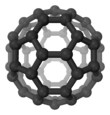Buckminsterfullerene
| |||
| Names | |||
|---|---|---|---|
| Pronunciation | /ˌbʌkmɪnstərˈfʊləriːn/ | ||
| Preferred IUPAC name
(C60-Ih)[5,6]fullerene[1] | |||
| Other names
Buckyballs; Fullerene-C60; [60]fullerene
| |||
| Identifiers | |||
3D model (
JSmol ) |
|||
| 5901022 | |||
| ChEBI | |||
| ChemSpider | |||
ECHA InfoCard
|
100.156.884 | ||
PubChem CID
|
|||
| UNII | |||
CompTox Dashboard (EPA)
|
|||
| |||
| |||
| Properties | |||
| C60 | |||
| Molar mass | 720.660 g·mol−1 | ||
| Appearance | Dark needle-like crystals | ||
| Density | 1.65 g/cm3 | ||
| insoluble in water | |||
| Vapor pressure | 0.4–0.5 Pa (T ≈ 800 K); 14 Pa (T ≈ 900 K) [2] | ||
| Structure | |||
| Face-centered cubic, cF1924 | |||
| Fm3m, No. 225 | |||
a = 1.4154 nm
| |||
| Hazards | |||
| GHS labelling: | |||

| |||
| Warning | |||
| H315, H319, H335 | |||
| P261, P264, P271, P280, P302+P352, P304+P340, P305+P351+P338, P312, P321, P332+P313, P337+P313, P362, P403+P233, P405, P501 | |||
Except where otherwise noted, data are given for materials in their standard state (at 25 °C [77 °F], 100 kPa).
| |||
| Part of a series of articles on |
| Nanomaterials |
|---|
 |
| Carbon nanotubes |
| Fullerenes |
| Other nanoparticles |
| Nanostructured materials |
Buckminsterfullerene is a type of
to its three neighbors.Buckminsterfullerene is a black solid that dissolves in hydrocarbon solvents to produce a violet solution. The substance was discovered in 1985 and has received intense study, although few real world applications have been found.
Molecules of buckminsterfullerene (or of fullerenes in general) are commonly nicknamed buckyballs.[3][4]
Occurrence
Buckminsterfullerene is the most common naturally occurring fullerene. Small quantities of it can be found in soot.[5][6]
It also
History

Theoretical predictions of buckminsterfullerene molecules appeared in the late 1960s and early 1970s.
Concurrent but unconnected to the Kroto-Smalley work, astrophysicists were working with spectroscopists to study infrared emissions from giant red carbon stars.[17][18][19] Smalley and team were able to use a laser vaporization technique to create carbon clusters which could potentially emit infrared at the same wavelength as had been emitted by the red carbon star.[17][20] Hence, the inspiration came to Smalley and team to use the laser technique on graphite to generate fullerenes.
Using laser evaporation of graphite the Smalley team found Cn clusters (where n > 20 and even) of which the most common were C60 and C70. A solid rotating graphite disk was used as the surface from which carbon was vaporized using a laser beam creating hot plasma that was then passed through a stream of high-density helium gas.[21] The carbon species were subsequently cooled and ionized resulting in the formation of clusters. Clusters ranged in molecular masses, but Kroto and Smalley found predominance in a C60 cluster that could be enhanced further by allowing the plasma to react longer. They also discovered that C60 is a cage-like molecule, a regular truncated icosahedron.[17][21]
Kroto, Curl, and Smalley were awarded the 1996 Nobel Prize in Chemistry for their roles in the discovery of buckminsterfullerene and the related class of molecules, the fullerenes.[11]
The experimental evidence, a strong peak at 720
In 1989 physicists
Another paper on the characterization and verification of the molecular structure followed on in the same year (1990) from their thin film experiments, and detailed also the extraction of an evaporable as well as
The discovery of practical routes to C60 led to the exploration of a new field of chemistry involving the study of fullerenes.
Etymology
The discoverers of the allotrope named the newfound molecule after R. Buckminster Fuller, who designed many geodesic dome structures that look similar to C60 and who had died in 1983, the year before discovery. This is slightly misleading, however, as Fuller's geodesic domes are constructed only by further dividing hexagons or pentagons into triangles, which are then deformed by moving vertices radially outward to fit the surface of a sphere.[26] Geometrically speaking, buckminsterfullerene is a naturally-occurring example of a Goldberg polyhedron. A common, shortened name for buckminsterfullerene is buckyballs.[27]
Synthesis
Soot is produced by laser ablation of graphite or
Structure
Buckminsterfullerene is a
60 molecule is about 0.71 nm. The C
60 molecule has two bond lengths. The 6:6 ring bonds (between two hexagons) can be considered "double bonds" and are shorter than the 6:5 bonds (between a hexagon and a pentagon). Its average bond length is 0.14 nm. Each carbon atom in the structure is bonded covalently with 3 others.[31] A carbon atom in the C
60 can be substituted by a nitrogen or boron atom yielding a C
59N or C59B respectively.[32]

Properties
| Centered by | Vertex | Edge 5–6 |
Edge 6–6 |
Face Hexagon |
Face Pentagon |
|---|---|---|---|---|---|
| Image | 
|
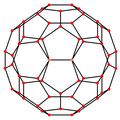
|
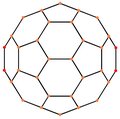
|
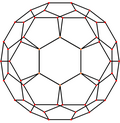
|

|
| Projective symmetry |
[2] | [2] | [2] | [6] | [10] |
For a time buckminsterfullerene was the largest known molecule observed to exhibit wave–particle duality.[33] In 2020 the dye molecule phthalocyanine exhibited the duality that is more famously attributed to light, electrons and other small particles and molecules.[34]
Solution
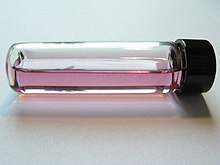
| Solvent | Solubility (g/L) |
|---|---|
1-chloronaphthalene
|
51 |
1-methylnaphthalene
|
33 |
1,2-dichlorobenzene
|
24 |
1,2,4-trimethylbenzene
|
18 |
tetrahydronaphthalene
|
16 |
| carbon disulfide | 8 |
1,2,3-tribromopropane
|
8 |
| xylene | 5 |
| bromoform | 5 |
| cumene | 4 |
| toluene | 3 |
| benzene | 1.5 |
| carbon tetrachloride | 0.447 |
| chloroform | 0.25 |
| n-hexane | 0.046 |
| cyclohexane | 0.035 |
| tetrahydrofuran | 0.006 |
| acetonitrile | 0.004 |
| methanol | 0.00004 |
| water | 1.3 × 10−11 |
| pentane | 0.004 |
| octane | 0.025 |
isooctane
|
0.026 |
| decane | 0.070 |
| dodecane | 0.091 |
| tetradecane | 0.126 |
dioxane
|
0.0041 |
| mesitylene | 0.997 |
| dichloromethane | 0.254 |
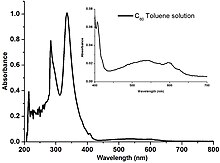
60 solution, showing diminished absorption for the blue (~450 nm) and red (~700 nm) light that results in the purple color.
Fullerenes are sparingly soluble in aromatic solvents and carbon disulfide, but insoluble in water. Solutions of pure C60 have a deep purple color which leaves a brown residue upon evaporation. The reason for this color change is the relatively narrow energy width of the band of molecular levels responsible for green light absorption by individual C60 molecules. Thus individual molecules transmit some blue and red light resulting in a purple color. Upon drying, intermolecular interaction results in the overlap and broadening of the energy bands, thereby eliminating the blue light transmittance and causing the purple to brown color change.[17]
C
60 crystallises with some solvents in the lattice ("solvates"). For example, crystallization of C60 from benzene solution yields triclinic crystals with the formula C60·4C6H6. Like other solvates, this one readily releases benzene to give the usual face-centred cubic C60. Millimeter-sized crystals of C60 and C
70 can be grown from solution both for solvates and for pure fullerenes.[38][39]
Solid
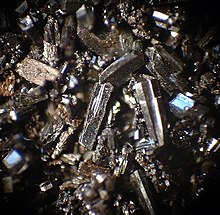

60 in crystal.
In solid buckminsterfullerene, the C60 molecules adopt the fcc (
C
60 solid is as soft as
60 films and solution have strong non-linear optical properties; in particular, their optical absorption increases with light intensity (saturable absorption).
C
60 forms a brownish solid with an optical absorption threshold at ≈1.6 eV.[41] It is an n-type semiconductor with a low activation energy of 0.1–0.3 eV; this conductivity is attributed to intrinsic or oxygen-related defects.[42] Fcc C60 contains voids at its octahedral and tetrahedral sites which are sufficiently large (0.6 and 0.2 nm respectively) to accommodate impurity atoms. When alkali metals are doped into these voids, C60 converts from a semiconductor into a conductor or even superconductor.[40][43]
Chemical reactions and properties
Redox (electron-transfer reactions)
C
60 undergoes six reversible, one-electron reductions, ultimately generating C6−
60. Its
Hydrogenation
C60 exhibits a small degree of aromatic character, but it still reflects localized double and single C–C bond characters. Therefore, C60 can undergo addition with hydrogen to give polyhydrofullerenes. C60 also undergoes Birch reduction. For example, C60 reacts with lithium in liquid ammonia, followed by tert-butanol to give a mixture of polyhydrofullerenes such as C60H18, C60H32, C60H36, with C60H32 being the dominating product. This mixture of polyhydrofullerenes can be re-oxidized by 2,3-dichloro-5,6-dicyano-1,4-benzoquinone to give C60 again.
A selective hydrogenation method exists. Reaction of C60 with 9,9′,10,10′-dihydroanthracene under the same conditions, depending on the time of reaction, gives C60H32 and C60H18 respectively and selectively.[45]
Halogenation
Addition of fluorine, chlorine, and bromine occurs for C60. Fluorine atoms are small enough for a 1,2-addition, while Cl2 and Br2 add to remote C atoms due to steric factors. For example, in C60Br8 and C60Br24, the Br atoms are in 1,3- or 1,4-positions with respect to each other. Under various conditions a vast number of halogenated derivatives of C60 can be produced, some with an extraordinary selectivity on one or two isomers over the other possible ones. Addition of fluorine and chlorine usually results in a flattening of the C60 framework into a drum-shaped molecule.[45]
Addition of oxygen atoms
Solutions of C60 can be oxygenated to the epoxide C60O. Ozonation of C60 in 1,2-xylene at 257K gives an intermediate ozonide C60O3, which can be decomposed into 2 forms of C60O. Decomposition of C60O3 at 296 K gives the epoxide, but photolysis gives a product in which the O atom bridges a 5,6-edge.[45]
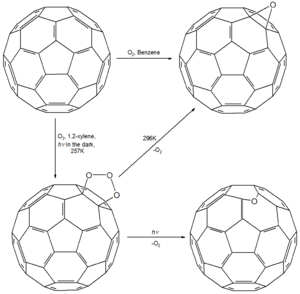
Cycloadditions
The Diels–Alder reaction is commonly employed to functionalize C60. Reaction of C60 with appropriate substituted diene gives the corresponding adduct.
The Diels–Alder reaction between C60 and 3,6-diaryl-1,2,4,5-tetrazines affords C62. The C62 has the structure in which a four-membered ring is surrounded by four six-membered rings.

The C60 molecules can also be coupled through a [2+2] cycloaddition, giving the dumbbell-shaped compound C120. The coupling is achieved by high-speed vibrating milling of C60 with a catalytic amount of KCN. The reaction is reversible as C120 dissociates back to two C60 molecules when heated at 450 K (177 °C; 350 °F). Under high pressure and temperature, repeated [2+2] cycloaddition between C60 results in polymerized fullerene chains and networks. These polymers remain stable at ambient pressure and temperature once formed, and have remarkably interesting electronic and magnetic properties, such as being ferromagnetic above room temperature.[45]
Free radical reactions
Reactions of C60 with
Stability of the radical species C60Y• depends largely on steric factors of Y. When tert-butyl halide is photolyzed and allowed to react with C60, a reversible inter-cage C–C bond is formed:[45]

Cyclopropanation (Bingel reaction)
Cyclopropanation (the Bingel reaction) is another common method for functionalizing C60. Cyclopropanation of C60 mostly occurs at the junction of 2 hexagons due to steric factors.
The first cyclopropanation was carried out by treating the β-bromomalonate with C60 in the presence of a base. Cyclopropanation also occur readily with
Redox reactions – C60 anions and cations
C60 anions
The
| Reduction potential of C60 at 213 K | |
|---|---|
| Half-reaction | E° (V) |
| C60 + e− ⇌ C− 60 |
−0.169 |
| C− 60 + e− ⇌ C2− 60 |
−0.599 |
| C2− 60 + e− ⇌ C3− 60 |
−1.129 |
| C3− 60 + e− ⇌ C4− 60 |
−1.579 |
| C4− 60 + e− ⇌ C5− 60 |
−2.069 |
| C5− 60 + e− ⇌ C6− 60 |
−2.479 |
C60 forms a variety of
- C60 + C2(NMe2)4 → [C2(NMe2)4]+[C60]−
This salt exhibits ferromagnetism at 16 K.
C60 cations
C60 oxidizes with difficulty. Three reversible oxidation processes have been observed by using
| Reduction potentials of C60 oxidation at low temperatures | |
|---|---|
| Half-reaction | E° (V) |
| C60 ⇌ C+ 60 |
+1.27 |
| C+ 60 ⇌ C2+ 60 |
+1.71 |
| C2+ 60 ⇌ C3+ 60 |
+2.14 |
Metal complexes
C60 forms complexes akin to the more common alkenes. Complexes have been reported
- M(CO)6 + C60 → M(η2-C60)(CO)5 + CO (M = Mo, W)
In the case of platinum complex, the labile ethylene ligand is the leaving group in a thermal reaction:
- Pt(η2-C2H4)(PPh3)2 + C60 → Pt(η2-C60)(PPh3)2 + C2H4
- (η5-Cp)2Ti(η2-(CH3)3SiC≡CSi(CH3)3) + C60 → (η5-Cp)2Ti(η2-C60) + (CH3)3SiC≡CSi(CH3)3
Coordinatively unsaturated precursors, such as Vaska's complex, for adducts with C60:
- trans-Ir(CO)Cl(PPh3)2 + C60 → Ir(CO)Cl(η2-C60)(PPh3)2
One such iridium complex, [Ir(η2-C60)(CO)Cl(Ph2CH2C6H4OCH2Ph)2] has been prepared where the metal center projects two electron-rich 'arms' that embrace the C60 guest.[46]
Endohedral fullerenes
Metal atoms or certain small molecules such as H2 and noble gas can be encapsulated inside the C60 cage. These endohedral fullerenes are usually synthesized by doping in the metal atoms in an arc reactor or by laser evaporation. These methods gives low yields of endohedral fullerenes, and a better method involves the opening of the cage, packing in the atoms or molecules, and closing the opening using certain
Endohedral fullerenes show distinct and intriguing chemical properties that can be completely different from the encapsulated atom or molecule, as well as the fullerene itself. The encapsulated atoms have been shown to perform circular motions inside the C60 cage, and their motion has been followed using
Potential applications in technology
The optical absorption properties of C60 match the solar spectrum in a way that suggests that C60-based films could be useful for photovoltaic applications. Because of its high electronic affinity[48] it is one of the most common electron acceptors used in donor/acceptor based solar cells. Conversion efficiencies up to 5.7% have been reported in C60–polymer cells.[49]
Potential applications in health
Ingestion and risks
C60 is sensitive to light,[50] so leaving C60 under light exposure causes it to degrade, becoming dangerous. The ingestion of C60 solutions that have been exposed to light could lead to developing cancer (tumors).[51][52] So the management of C60 products for human ingestion requires cautionary measures[52] such as: elaboration in very dark environments, encasing into bottles of great opacity, and storing in dark places, and others like consumption under low light conditions and using labels to warn about the problems with light.
Solutions of C60 dissolved in olive oil or water, as long as they are preserved from light, have been found nontoxic to rodents.[53]
Otherwise, a study found that C60 remains in the body for a longer time than usual, especially in the liver, where it tends to be accumulated, and therefore has the potential to induce detrimental health effects.[54]
Oils with C60 and risks
An experiment in 2011–2012 administered a solution of C60 in olive oil to rats, achieving a major prolongation of their lifespan.[53] Since then, many oils with C60 have been sold as antioxidant products, but it does not avoid the problem of their sensitivity to light, that can turn them toxic. A later research confirmed that exposure to light degrades solutions of C60 in oil, making it toxic and leading to a "massive" increase of the risk of developing cancer (tumors) after its consumption.[51][52]
To avoid the degradation by effect of light, C60 oils must be made in very dark environments, encased into bottles of great opacity, and kept in darkness, consumed under low light conditions and accompanied by labels to warn about the dangers of light for C60.[52][50]
Some producers have been able to dissolve C60 in water to avoid possible problems with oils, but that would not protect C60 from light, so the same cautions are needed.[50]
References
- ISBN 978-0-85404-182-4.
- .
- ^ "Buckyball". Oxford English Dictionary. Oxford University Press. Retrieved 13 April 2024.
- ^ The AZo Journal of Materials Online. AZoM.com. "Buckminsterfullerene." 2006.
- S2CID 37159968.
- .
- S2CID 33588270.
- S2CID 118739732.
- S2CID 118684608.
- S2CID 205244293.
- ^ a b c Katz, 363
- ^ Osawa, E. (1970). Kagaku (Kyoto) (in Japanese). 25: 854
- ^ Jones, David E. H. (1966). "Hollow molecules". New Scientist (32): 245.
- ^ .
- doi:10.1063/1.447994.
- S2CID 4314237.
- ^ ISBN 978-012-221820-0.
- doi:10.1086/153400.
- Bibcode:1988A&A...203..145L.
- doi:10.1063/1.440991.
- ^ S2CID 4314237.
- ^ Conference proceedings of "Dusty Objects in the Universe", pp.b 89–93, "Search for the UV and IR spectra of C60 in laboratory-produced carbon dust" Archived 2017-09-05 at the Wayback Machine
- .
- ^ a b Buckminsterfullerene, C60 Archived 2021-02-27 at the Wayback Machine. University of Bristol. Chm.bris.ac.uk (1996-10-13). Retrieved on 2011-12-25.
- S2CID 4359360.
- ^ "What is a geodesic dome?". R. Buckminster Fuller Collection: Architect, Systems Theorist, Designer, and Inventor. Stanford University. 6 April 2017. Archived from the original on 12 January 2020. Retrieved 10 June 2019.
- ^ The AZo Journal of Materials Online. AZoM.com. "Buckminsterfullerene." 2006.
- ISBN 978-0935702484.
- ^ Katz, 369–370
- ISBN 978-0-19-923617-6.
- ^ Katz, 364
- ^ Katz, 374
- ^
Arndt, Markus; Nairz, Olaf; Vos-Andreae, Julian; Keller, Claudia; Van Der Zouw, Gerbrand; Zeilinger, Anton (1999). "Wave–particle duality of C60". S2CID 4424892.
- ^ Lee, Chris (2020-07-21). "Wave-particle duality in action—big molecules surf on their own waves". Ars Technica. Archived from the original on 2021-09-26. Retrieved 26 September 2021.
- ^ Beck, Mihály T.; Mándi, Géza (1997). "Solubility of C60". Fullerenes, Nanotubes and Carbon Nanostructures. 5 (2): 291–310. .
- S2CID 250785669.
- ^ Ruoff, R. S.; Tse, Doris S.; Malhotra, Ripudaman; Lorents, Donald C. (1993). "Solubility of fullerene (C60) in a variety of solvents". .
- ^ Talyzin, A. V. (1997). "Phase Transition C60−C60*4C6H6 in Liquid Benzene". .
- .
- ^ a b Katz, 372
- ^ Katz, 361
- ^ Katz, 379
- ^ Katz, 381
- ^ S2CID 40552372.
- ^ ISBN 978-0-13-175553-6.
- ^ ISBN 978-0-470-51233-3.
- PMID 21505658.
- .
- from the original on 2021-11-26. Retrieved 2021-11-26.
- ^ a b c "Degradation of C60 by light" (PDF). Nature. Vol. 351. 23 May 1991.
- ^ a b Grohn, Kristopher J. "Comp grad leads research". WeyburnReview. Archived from the original on 2021-04-17. Retrieved 2021-04-17.
- ^ a b c d Grohn, Kristopher J.; et al. "C60 in olive oil causes light-dependent toxicity" (PDF). Archived (PDF) from the original on 2021-04-15. Retrieved 2021-04-15.
- ^ PMID 22498298.
- PMID 30257131.
Bibliography
- Katz, E. A. (2006). "Fullerene Thin Films as Photovoltaic Material". In Sōga, Tetsuo (ed.). Nanostructured materials for solar energy conversion. Elsevier. pp. 361–443. ISBN 978-0-444-52844-5.
Further reading
- Kroto, H. W.; Heath, J. R.; O'Brien, S. C.; Curl, R. F.; Smalley, R. E. (November 1985). "C60: Buckminsterfullerene". Nature. 318 (14): 162–163. S2CID 4314237. – describing the original discovery of C60
- Hebgen, Peter; Goel, Anish; Howard, Jack B.; Rainey, Lenore C.; Vander Sande, John B. (2000). "Fullerenes and Nanostructures in Diffusion Flames" (PDF). Proceedings of the Combustion Institute. 28: 1397–1404. . – report describing the synthesis of C60 with combustion research published in 2000 at the 28th International Symposium on Combustion
External links
- History of C60's discovery carried out by the Chemistry Department at Bristol University
- A brief overview of buckminsterfullerene described by the University of Wisconsin-Madison
- A report by Ming Kai College detailing the properties of buckminsterfullerene
- Donald R. Huffman and Wolfgang Krätschmer's paper pertaining to the synthesis of C60 in Nature published in 1990
- A thorough description of C60 by the Oak Ridge National Laboratory
- An article about buckminsterfullerene on Connexions Science Encyclopaedia
- Extensive statistical data compiled by the University of Sussex on the numerical quantitative properties of buckminsterfullerene
- A web portal dedicated to buckminsterfullerene, authored and supported by the University of Bristol
- Another web portal dedicated to buckminsterfullerene, authored and supported by the Chemistry Department at the University of Bristol
- A brief article entirely devoted to C60 and its discovery, structure, production, properties, and applications
- American Chemical Society's complete article on buckminsterfullerene
- Buckminsterfullerene at The Periodic Table of Videos(University of Nottingham)


